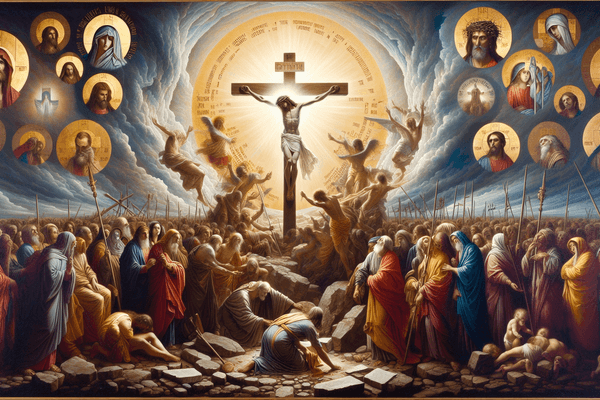The Earthquake and Rocks Splitting at Jesus' Death
At the moment of Jesus' death, the Gospels recount a great earthquake, a testament to the transformative power of His sacrifice. The Gospel of Matthew vividly illustrates this event, stating that 'the earth shook, and the rocks split' (Matthew 27:51), symbolizing not only a physical but also a spiritual upheaval. This dramatic display of nature's force serves as a metaphor for the tearing of the veil between the divine and the human, marking the end of the old covenant and the ushering in of a new era. Such imagery is not unique to the New Testament; throughout the Bible, earthquakes signify God's presence and power, as seen when Paul and Silas were freed from prison (Acts 16:26), or in John's apocalyptic vision (Revelation 6:12). The Old Testament too speaks of the earth shaking at the presence of the Lord, as on Mount Sinai (Exodus 19:18) and in David's psalms (Psalm 18:7). The splitting rocks at Jesus' crucifixion thus stand as an eternal reminder of the momentous change His death brought to the world.
The Crucifixion of Jesus: Biblical Descriptions and Theology
The crucifixion of Jesus is central to Christian faith, a pivotal event that bridges the Old and New Testaments. The Gospels provide detailed accounts of the crucifixion, portraying not only the physical agony Jesus endured but also the spiritual significance of His death. His crucifixion fulfilled the messianic prophecies of the Old Testament, such as those found in Isaiah 53:5, which speaks of the suffering servant who bore our sins. The New Testament narratives, from the division of Jesus' garments in Matthew 27:35 to His final words on the cross in John 19:30, emphasize the sacrificial nature of His death. This act of ultimate love and atonement is reflected in the words of Jesus Himself, 'Father, forgive them, for they do not know what they are doing' (Luke 23:33). Thus, the crucifixion represents the profound love of God, who through Jesus, provided a means for humanity's redemption. To further explore the transformative power of such profound love, consider the role of prayer in the Christian life, an intimate conversation with the divine that can deepen your spiritual journey.
Seeking and Finding Eternal Truths
The pursuit of understanding and truth is encouraged within the Christian tradition. The Bible urges seekers to 'ask and it will be given to you; seek and you will find; knock and the door will be opened to you' (Matthew 7:7). This call for active searching is echoed in the Old Testament, with promises that those who seek the Lord wholeheartedly will find Him (Jeremiah 29:13). Wisdom literature such as Proverbs 8:17 also reinforces this idea, assuring that those who love wisdom—often synonymous with God—will be loved in return. In the New Testament, the apostle John emphasizes that knowing God is intrinsically linked to love, stating, 'Dear friends, let us love one another, for love comes from God. Everyone who loves has been born of God and knows God' (1 John 4:7-8). This exploration of faith is not solitary but communal, as believers are encouraged to draw near to God together (James 4:8), thereby discovering the depth of love and truth in the Christian gospel.
Conclusion
As we reflect on the crucifixion of Jesus and its enduring impact, we are reminded of the profound spiritual truths embedded within the Christian narrative. We have explored the significance of Jesus' death, the principles guiding interfaith relationships, and the call to seek and understand the deeper meanings of love and faith. The scriptures challenge us to live out these principles in our daily lives, encouraging a harmonious balance between holding steadfast to our beliefs and extending love and respect to those around us. In doing so, we embody the essence of Christianity, which is to love God and to love others as ourselves. May this exploration inspire readers to deepen their faith, engage in meaningful dialogue with others, and continue the journey of discovering the vast riches of God's love.





